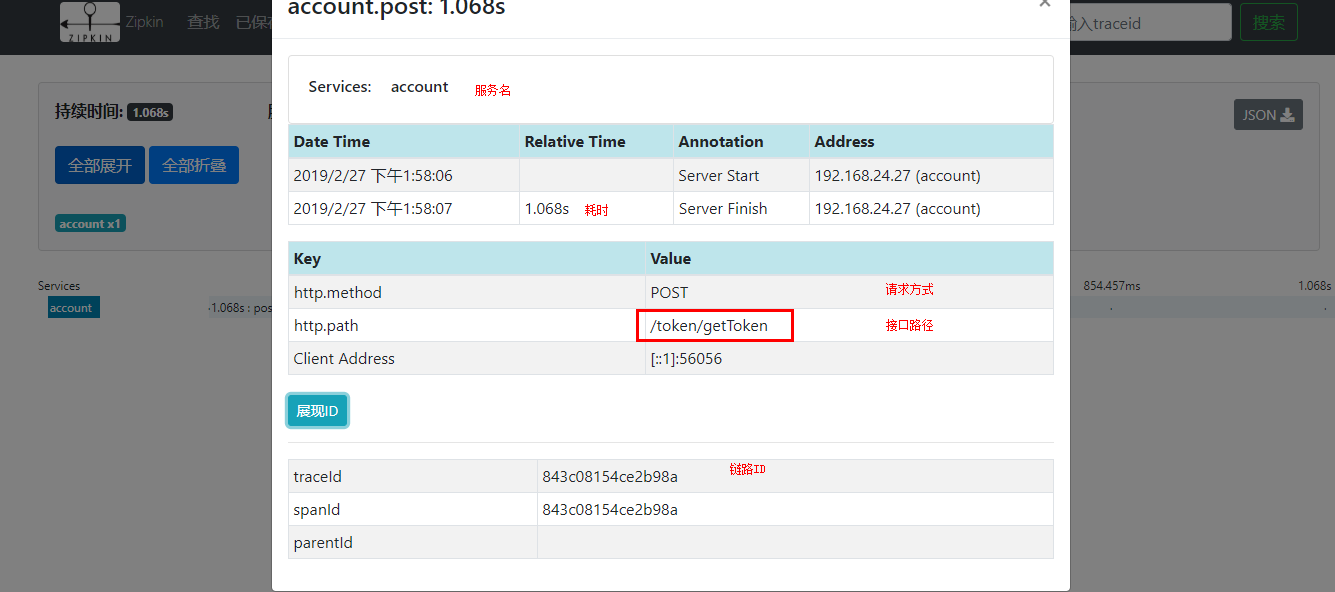
Zipkin是一种分布式跟踪系统,它有助于收集解决微服务架构中得延迟问题所需的时序数据,它管理这些数据的收集和查找。
应用程序用户向Zipkin报告时序数据,Zipkin UI还提供了一个依赖关系图,显示了每个应用程序通过的跟踪请求数。如果要解决延迟问题或错误,可以根据应用程序,跟中长度,注释或时间戳对所有跟踪进行筛选或排序。选择跟踪后,您可以看到每个跨度所需的总跟踪时间百分比,从而可以识别应用程序呈现的问题。
官网:https://zipkin.io/
快速开始
以下的过程中,我们将介绍构建和启动Zipkin实例,以便在本地检查Zipkin。根据官网显示,有三种选择:使用Java、Docker或从源代码运行。
如果您熟悉Docker,这是首选的方法。如果您不熟悉Docker,请尝试通过Java或源代码运行。
Zipkin分为两端,一个是Zipkin服务端,一个是Zipkin客户端(微服务应用)。客户端会配置服务端的URL地址,一旦服务间调用的时候,会被配置在微服务里面的Sleuth的监听器监听,并生成相应的Trace和Span信息发送给服务端。
发送的方式主要有两种,一种是Http报文的方式,还有一种是消息总线的方式如:RabbitMQ
我们这边采用的是Http报文的方式。
Zipkin服务端
1. 引入依赖
<dependencies>
<!-- zipkin server -->
<dependency>
<groupId>io.zipkin.java</groupId>
<artifactId>zipkin-server</artifactId>
<exclusions>
<exclusion>
<groupId>org.springframework.boot</groupId>
<artifactId>spring-boot-starter-log4j2</artifactId>
</exclusion>
</exclusions>
<version>${zipkin}</version>
</dependency>
<!-- zipkin ui -->
<dependency>
<groupId>io.zipkin.java</groupId>
<artifactId>zipkin-autoconfigure-ui</artifactId>
<version>${zipkin}</version>
</dependency>
</dependencies>
${zipkin}:<zipkin>2.12.2</zipkin>
2. 配置文件
spring: application: name: zipkin-server security: user: name: zhangsan password: 111111 --- # 服务端口 server: port: 9411 --- eureka: instance: # 解决健康节点权限问题 将用户名及密码放入eureka的元数据中 metadata-map: user.name: ${spring.security.user.name} user.password: ${spring.security.user.password} client: service-url: defaultZone: http://${spring.security.user.name}:${spring.security.user.password}@peer1:8761/eureka/,http://${spring.security.user.name}:${spring.security.user.password}@peer2:8762/eureka/ --- # 客户端负载均衡器 ribbon: ConnectTimeout: 3000 # 客户端连接超时 ReadTimeout: 60000 # 客户端读取超时 MaxAutoRetries: 1 # 当前环境最大重试次数 MaxAutoRetriesNextServer: 2 # 其他环境最大重试次数 eureka: enabled: true --- hystrix: command: default: execution: timeout: enabled: false --- # 关闭自动配置启用所有请求得检测 management: metrics: web: server: auto-time-requests: true
3. 重写 WebMvcTagsProvider
解决问题:
java.lang.IllegalArgumentException: Prometheus requires that all meters with the same name have the same set of tag keys. There is already an existing meter containing tag keys [method, status, uri]. The meter you are attempting to register has keys [exception, method, status, uri].
a、将management.metrics.web.server.auto-time-requests=false设置为false,默认为true
b、重写WebMvcTagsProvider
package com.sinosoft.config; import io.micrometer.core.instrument.Tag; import io.micrometer.core.instrument.Tags; import org.springframework.boot.actuate.metrics.web.servlet.WebMvcTags; import org.springframework.boot.actuate.metrics.web.servlet.WebMvcTagsProvider; import javax.servlet.http.HttpServletRequest; import javax.servlet.http.HttpServletResponse; /** * @ClassName: MyTagsProvider * @Description: TODO * @author: Created by xxx <a href="[email protected]">Contact author</a> * @date: 2019/2/27 13:49 * @Version: V1.0 */ public class MyTagsProvider implements WebMvcTagsProvider { /** * 去掉WebMvcTags.exception(exception) * * @param request 请求 * @param response 响应 * @param handler 处理 * @param exception 异常 * @return */ @Override public Iterable<Tag> getTags(HttpServletRequest request, HttpServletResponse response, Object handler, Throwable exception) { return Tags.of(WebMvcTags.method(request), WebMvcTags.uri(request, response), WebMvcTags.status(response)); } @Override public Iterable<Tag> getLongRequestTags(HttpServletRequest request, Object handler) { return Tags.of(WebMvcTags.method(request), WebMvcTags.uri(request, null)); } }
注入:MyTagsProvider
package com.sinosoft.config; import org.springframework.context.annotation.Bean; import org.springframework.context.annotation.Configuration; /** * @ClassName: TagsProvideBean * @Description: TODO * @author: Created by xxx <a href="[email protected]">Contact author</a> * @date: 2019/2/27 13:54 * @Version: V1.0 */ @Configuration public class TagsProvideBean { /** * 将MyTagsProvider注入 * * @return */ @Bean public MyTagsProvider myTagsProvider() { return new MyTagsProvider(); } }
4. 启动服务
package com.sinosoft; import org.springframework.boot.SpringApplication; import org.springframework.boot.autoconfigure.SpringBootApplication; import org.springframework.cloud.client.discovery.EnableDiscoveryClient; import zipkin2.server.internal.EnableZipkinServer; /** * @ClassName: ZipkinApplication * @Description: 调用链服务启动入口 * @author: Created by xxx <a href="[email protected]">Contact author</a> * @date: 2019/2/27 11:43 * @Version: V1.0 */ @SpringBootApplication @EnableDiscoveryClient @EnableZipkinServer public class ZipkinApplication { public static void main(String[] args) { SpringApplication.run(ZipkinApplication.class, args); } }
Zipkin客户端
1. 引入依赖
<!-- 调用链 ZipKin -->
<dependency>
<groupId>org.springframework.cloud</groupId>
<artifactId>spring-cloud-starter-zipkin</artifactId>
</dependency>
注:spring-cloud-starter-zipkin 已经包含了 spring-cloud-starter-sleuth

2. 配置文件
--- # 调用链 Sleuth + ZipKin spring: sleuth: web: client: enabled: true sampler: probability: 1.0 # 采用比例,默认 0.1 全部采样 1.0 zipkin: base-url: http://localhost:9411/ # 指定了Zipkin服务器的地址
Zipkin效果展示

